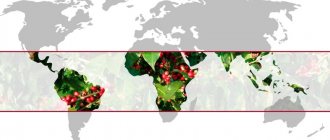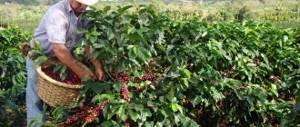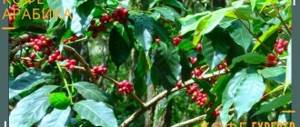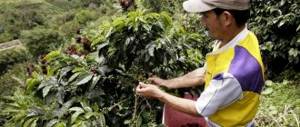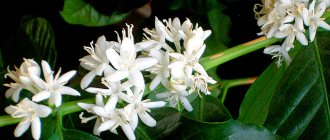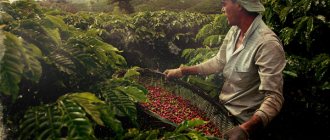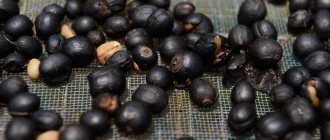Ethiopian coffee is both a separate variety and a collective name for types of coffee. Ethiopia is a unique place where Arabica is still preserved in its original form. For a long time, the local population was not interested in coffee beans, but brewed tea from the leaves, and made strong tinctures from the fruits. And now wild trees have been preserved there, although a significant part of the territory has already been planted by human hands.
The majority of the country's residents are engaged in the cultivation and processing of coffee, and the state receives profit from exports. But at the same time, a decent amount of beans also goes to the domestic market, since locals highly value coffee.
History of Coffee in Ethiopia
Even in ancient times, people began to consume parts of the coffee tree in their diet. And the first to discover coffee were the Ethiopians - a population living before our era in the province of Kaffa - this is Ethiopia in our time.
The fruits were crushed and combined with animal fat; edible balls were formed from this mass, which they carried with them to refresh themselves. The juice extracted from the fruit was used to prepare a drink reminiscent of wine, and the leaves were brewed to produce an analogue of tea.
Only over time, Ethiopians began to heat water and use coffee beans to prepare the drink. Such drinks were initially part of rituals associated with religion. And Ethiopian coffee became a drink of national importance much later, a national drink. Wood processing: the process of collecting leaves and grains, has become a separate craft.
Ethiopia is the birthplace of coffee
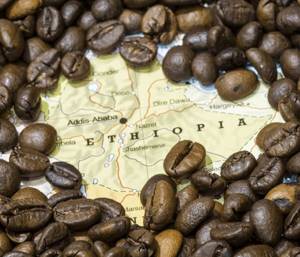
According to ancient legends, a resident from the province of Kaffa, while grazing a herd of goats, discovered strange berries. Having tried them, he felt cheerfulness and energy, so he hastened to share his find with the believing hermit.
He did not listen to the shepherd and ordered to immediately get rid of the hellish fruits by throwing them into the fire. But everything changed when the aroma of coffee began to spread throughout the area, they began to take out grains and fire and pour water on them. So, by absolute chance, they discovered the original drink.
Growing and processing conditions
Ethiopia is a country, the main part of which is located at an altitude of one and a half kilometers above sea level. Basically, profitable products are produced on small farms, with a volume of more than three hundred thousand tons per year.
The country's tropical climate is optimal for growing coffee trees. Locals are engaged in harvesting from August, until January. The main variety of Ethiopian coffee grown here is Arabica, although its varieties are also found in some areas of the country.
Most of the coffee trees grew in nature on their own, and people only had to pick the ripe berries. This wild Arabica, devoid of care, produces a small harvest, and it is very difficult to collect berries in the thickets of the forest, so it is possible to obtain about twenty kilograms of raw materials per day.
About a third of the total harvest is harvested in special prepared areas. The soil is fertilized with special substances without using chemical components.
The local authorities did not deign to produce the necessary documents for Ethiopian coffee, so export occurs without the appropriate certificates.
Coffee cultivation in Ethiopia is facilitated by favorable climatic and landscape conditions - namely:
- special natural conditions - provides natural watering in the form of rain, and excellent protection from the sun - huge trees,
- mountainous terrain and soil near volcanoes, very fertile,
- absence of bad weather events and sudden temperature changes.
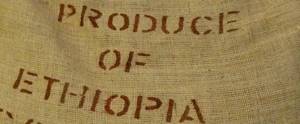
Ethiopia grows most of its coffee beans not on plantations, but in forests:
- wild trees are profitable because they produce the harvest themselves and producers do not have to plant seedlings. The soil near the volcanoes provides fertilizer and the rain provides watering.
- The disadvantage of wild coffee trees is that they grow at different heights and harvesting cannot be automated. This creates enormous human labor costs, although it solves the problem of jobs for the population.
Ethiopian coffee: Arabica forever
Let’s not repeat for the hundredth time the well-known pastoral story about a shepherd and his goats, who gave local residents the bright idea of using the fruits of the coffee tree. The history of this drink is replete with other, no less interesting and dramatic stories. Ethiopia, or, as it was previously called, Abyssinia, is considered the most ancient country on our planet. It has seen periods of decline and prosperity, but every part of its history is inextricably linked with coffee. It was used by harsh Abyssinian warriors as a stimulant during long marches. Merchants prepared small balls from grains mixed with oil that supported strength. Before people learned to husk, grind and brew coffee beans, coffee berries were used to prepare a low-alcohol drink.
Coffee beans traveled with slaves, spreading throughout the country. Today's Ethiopia is also filled with coffee, literally and figuratively. About half of the collected grains are exported, the rest are consumed domestically. In Ethiopia, a real cult of coffee has formed, which is drunk three times a day. At the same time, the matter is not limited to one cup. For example, a guest drinks at least three servings of a drink at a time. Anything less is considered simply disrespectful to the owners of the house and to the coffee itself, which is called “our bread” here. And this is not just a metaphor. About a quarter of the country's total population is involved in the collection and processing of this crop.
Annual coffee production ranges from 200 to 240 thousand tons. The country provides about 30% of the world's Arabica production.
There is only one type of coffee tree growing in Ethiopia. In the overwhelming majority, this is precisely the historical, one might say, original variety that laid the foundation for the entire world coffee history - Coffee Arabica.
Historians call Ethiopia the cradle of modern civilization. This country rightfully deserves the title of the cradle of coffee.
Despite the fact that the hot and arid, typically African climate of the Ethiopian plains strongly impedes farming, natural coffee plantations thrive in the highlands of the country. An abundance of sun, comfortable temperature, a good combination of humidity and the absence of sudden weather changes are the best way to promote the growth of coffee trees.
Surprisingly, most of the coffee harvested in Ethiopia is wild Arabica. Yes exactly. The country even has a special name for such beans – forest coffee. No one grows them; nature itself takes care of everything. Peasants only collect and process coffee berries.
Where natural plantations grow too densely, interfering with each other, they are thinned out, sometimes by planting cultivated seedlings next to wild trees. The resulting varieties are called semi-forest.
About 40% of the harvest comes from man-made plantations cultivated by human hands. Most of them are quite small garden plots, where one family works. Only about 5% of the coffee harvest comes from industrial coffee plantations.
Most of the coffee beans harvested in Ethiopia are dry-processed, as has been done for hundreds and hundreds of years before. Although the most expensive, one might say elite, varieties are now subject to wet processing.
Technologies for growing and producing coffee in Ethiopia
The terrain features of Africa force us to grow coffee trees together with banana trees, but this only has a beneficial effect on the result, because they perfectly nourish the soil and protect well from wind and temperature fluctuations.
Ethiopia is a country with a low standard of living, and innovations in coffee processing are not known here. Processing of raw materials occurs in a dry way and is done manually.
- the harvested crop is simply dried under the sun on the leaves of a banana tree,
- drying the grains takes half a month, during the entire time they are regularly mixed and protected from pests,
- when the percentage of water in the grains reaches twelve, they begin to be cleaned,
- The grains are cleaned using a sieve and sorted.
This processing method does not exclude the entry of low-quality grain, but the quality of taste does not suffer from this.
Wet processing technology requires significant financial costs and requires the availability of clean running water. Therefore, it is used less often and a small percentage of the crop is processed in this way. Coffee that has undergone this type of processing has a pure taste, but its price is much higher than usual.
The consumer can determine the method of processing Ethiopian coffee using special markings and descriptions, where the wet method is designated by the numbers 2, 3, and the dry method by 4 and 5. But the surest way to determine the best is the personal taste sensations of the taster.
Recently, in order to maintain product prices and to control the quality of the finished product, all Ethiopian coffee on the market is presented under the sign of the Ethiopian Commodity Exchange. This has negatively affected the individuality of the varieties, and it is now impossible to find out details about the product.
Real Ethiopian coffee, prepared using the wet method, at affordable prices, is always in stock in our online store.
Ethiopia Sidamo
Information from the product page Roasting roaster: Probat Probatone 25 Roasting level: filter (51 on the ColorTrack scale) Processing method: washed Screen (grain size): 15+ Region: Sidamo Growing altitude: 1600–1900 m Q-grader rating: 84.5
V There are several coffee growing regions in Ethiopia, the main ones being Yirgacheff, Sidamo, Harrar, Lekempti, Limu and Jimma. The taste in each of these regions differs due to differences in microclimate, landscape features, and local varieties of coffee.
The Sidamo region is located on the plateau of Southern Ethiopia, where the altitude reaches 1900 meters above sea level. This is a more balanced coffee than Yirgacheff with hints of tropical fruit on the palate.
Bright floral notes, tropical fruits and ripe lemon acidity
Comes in a bag with the company logo and a yellow label

Here's what's on the label

Recommendations for drinking coffee on the back of the bag
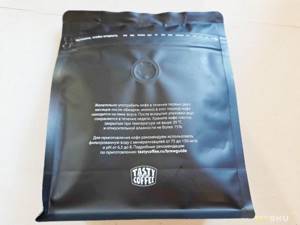
At the bottom there is a description of where the QR code leads and what it gives

The package is equipped with a zip tape to preserve the taste and aroma
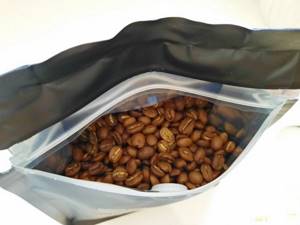
When opened, we are bombarded with the aroma of coffee, no mustiness or negative impurities, as after opening some Paulig or Oro. And of course, a valve for removing carbon dioxide

Let's check the weight. Almost exactly
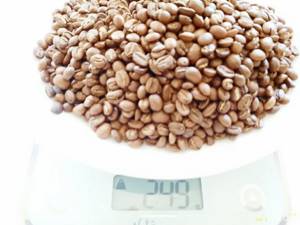
Here are the grains themselves, the roasting is uniform, the grains are not crushed, it looks like they are from the same variety
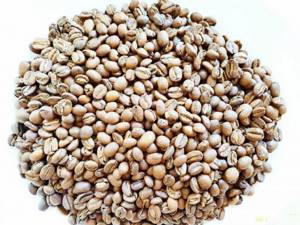
Let's take a closer look at the grains under the spoiler
Additional Information
I make coffee in a Bosch VeroCap 100 coffee machine. Its coffee compartment holds exactly 250 grams of coffee
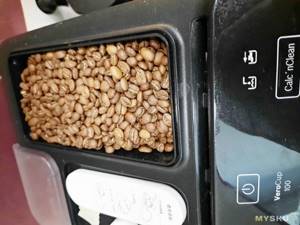
Let's start making coffee. I’ll say right away that I prefer cappuccino and I couldn’t drink this type of coffee in espresso, it has a very rich acidic taste. That's why I make cappuccino

This coffee is good for those who like a drink with a twist, I would not choose it for everyday use, but I liked the acidic aftertaste. It's like the icing on the cake after a sip. Curious sensations. Glad I tried it. There is an unobtrusive sourness here, like in the LAVAZZA “Qualita ORO” variety, which I couldn’t finish at all. But it is there. For lovers of the fresh aroma of coffee with sourness, I recommend this coffee.

Hand-picked Arabica
The large-scale export of coffee to markets in neighboring countries did not make Ethiopia a rich state. Therefore, coffee is grown mainly by small farmers, and the main processes are performed manually. Collecting fruits is a complex, meticulous process and requires a lot of experience from workers. Drying of grains is also not automated and therefore occurs gradually.

Ethiopia is the cradle of coffee, because from Africa it spread to other continents.
Ethiopian coffee varieties
Only the best beans, selected by the calloused hands of local aborigines, create Ethiopian coffee, and care and knowledge of the matter help to separate Arabica varieties:
- Arabica coffee Ethiopia Harrar is an elite variety from the province with the same name. The technology of roasting the beans gives the taste of chocolate, a slight sour taste, which makes the variety ideal for moccacino.
- Multifaceted Lekempti is a coffee variety from Ethiopia, distinguished by its aroma of fruits and flowers, and a slight astringency.
- Limu is an Ethiopian coffee made from round shaped beans, and therefore has a special taste and aroma.
- Ethiopia Sidamo coffee is coffee from the mountaintops, infused with plant aromas that reveal grape and floral notes. The coffee beans are medium-density because they are dry-processed.
- Arabica coffee Jimma is a variety that forms a dense foam when cooked, has a tart taste with a grape tint, and retains a pleasant aftertaste for a long time.
- For the mixtures, a coffee variety called Tepi is used. The coffee is rich in the smell of lime and light citrus sourness.
- Irgacheffe coffee is a purely aristocratic variety that is suitable for both mixing and drinking on its own. Irgacheffe coffee has a rich tart taste with spicy and floral notes.
- Ethiopian coffee beans are distinguished by fruity notes, which are imbued with them from nearby trees bearing sweet fruits.
How to choose the right varieties of Ethiopian coffee?
In modern society, people are accustomed to trusting only branded products. Often ready to say goodbye to a large sum of money because of it, they believe that they are purchasing a 100% quality product. However, unlicensed Arabica varieties can also be considered worthy of recognition. For example, such unique species as Volisho, Dega, Sinde, Kubure, Kudume. Ethiopia is the birthplace of coffee. Consequently, almost every product released from her pen will be of high quality.
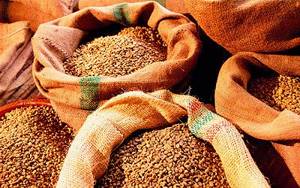
A similar situation exists with the “environmentally friendly” marker. It has been scientifically proven that half of the coffee grown in Ethiopia is classified as forest coffee - free-growing. There is no reason to worry about the health safety of such a product.
A strong degree of roasting of Ethiopian coffee is categorically unacceptable. The refined base for preparing an aromatic drink loses its unique taste. The normal color of the grain is similar to a light shade of caramel. Only then will both the gourmet and the newcomer to the coffee world be able to fully experience the unique aroma and taste of a freshly brewed drink.
You can often find the following markings on packaging of coffee from Ethiopia:
- Extra-Sifted – coarse coffee
- Longberry - medium grain
- Shortberry - fine-grained.
Well, as for the price for the goods, it cannot be called democratic. On average, African Arabica beans are sold on the market from 2,000 rubles per kg.
Exclusive varieties of Ethiopian coffee beans
On the world stage, each country stands out with some special product, as national pride. In a country with the amazing name Ethiopia, there is a special product - coffee. Ethiopia coffee is a one-of-a-kind raw material, the export of which to different parts of the world is under strict control.
The variety of varieties of this coffee is impressive, but the main three should be highlighted based on taste characteristics:
| Ethiopia Yirgacheffe - fractional grain grown in the province of Sidamo, and processed using a wet method, and therefore is considered elite. When cooked, it is an amazing product with a fruity floral aroma and a chocolate and citrus taste. |
| Ethiopia Sidamo (ethiopia sidamo) - coffee from the south of the country, which is processed in an expensive way, because it is famous for the taste of chocolate and aroma of bergamot, with the sourness characteristic of Arabica coffee. |
| Ethiopia Harrar ( Ethiopia Mocha Sidamo ) is coffee made from forest beans, therefore it has a nutty-citrus taste and a moderately sour and bitter aftertaste. |
Ethiopian coffee varieties
For many years, Ethiopian coffee was exported through intermediaries, bringing fabulous profits to the latter. Not long ago, the government decided to take exports into its own hands, and in order to maintain the famous quality of grains at a uniform level, several trademarks were registered.
Each of them is labeled with a specific variety, well known to all connoisseurs of Ethiopian coffee.
Harar
The variety got its name from the province in which it is grown. The Harar region is located in the east of the country; this mountainous region has a very rich history. Previously, the capital of Ethiopia was located here, and even now Muslims around the world revere Harar as a famous and respected center of Islam. Harar coffee is a forest variety and grows at an altitude of about 2,000 thousand meters above sea level. It has an expressive nutty-chocolate taste and fruity aroma. The sourness characteristic of Arabica is moderately expressed, and a piquant, bitter note is felt in the aftertaste. This variety has three categories, which differ in grain size. There is also a special type of Harara, which is obtained from fused beans of the Peaberry coffee berry variety. They are highly valued by connoisseurs for their delicious, vibrant aroma consisting of notes of chocolate, spice and citrus.
IMPORTANT. Often grains of this variety do not have a very advertising appearance. Small, deformed, with uneven edges or cracks. This is a feature of natural coffee from Ethiopia, so there is no need to be afraid of it.
Sidamo
It is collected in the province of the same name in the southern part of the country. Like other famous and successful varieties, this is highland coffee. It is distinguished by wet processing. Externally, the grains of this variety, like the famous Harar, look rather modest. They are often twisted, flattened, and do not have such a beautiful, even and decorative shape as cultivated varieties. But their excellent gastronomic qualities make up for all the shortcomings in appearance. Sidamo coffee is distinguished by a velvety, palate-caressing chocolate taste, which is diversified by traditional sourness. The aroma is sweetish, with distinct notes of vanilla, bergamot and fruit. It has a persistent caramel-creamy aftertaste with a slight bitterness.
Yirgacheffe
Grown in the same province of Sidamo, considered one of the best varieties. The grains are processed wet and collected only when fully ripe. This type of coffee is distinguished by small, even, neat grains. The expressive fruity-floral aroma is complemented by berry notes. The taste of the finished drink is dense, chocolate-fruity, with orange sourness. The aftertaste, like most Ethiopian coffees, is persistent, fruity, sometimes with floral or citrus notes.
In addition to these three state-branded varieties, Ethiopia supplies many other regional varieties that have an excellent reputation among coffee connoisseurs and lovers.
Two-thirds of the total crop is grown in the southwest of the country. The Lima and Babek varieties stand out here, which have an expressive, bright taste and a memorable fruit and wine aroma with chocolate notes. Lecampt is another variety that surprises not only with its richness of taste, but also with its unusual wine aroma. Its aftertaste has a hint of fruit and spice. Worth mentioning are Illubabor and Tepi, which are also grown in the southwest, harvested by hand and processed in the same way as hundreds of years ago, using the dry method.
The province of Kaffa, which, in fact, gave its name to the beans, and then to the drink made from them, still remains a very active participant in coffee production. The varieties that stand out here are Gimbi and Lekempti, which have a deep chocolate taste, a balanced aroma with light notes of spices and fruits, and moderate acidity.
IMPORTANT. Coffee labeled Mocha Style is not an independent variety. This is a mixture that contains the most substandard grains.
Mocha Style is a so-called commercial mix, which contains beans of different varieties. It may turn out to be quite good, and besides, its cost is somewhat lower than that of well-known single varieties.
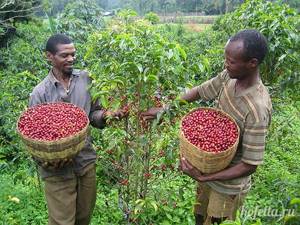
Ethiopian coffee
Traditionally, Ethiopians choose medium-roasted beans for the coffee ceremony, and use one of the following methods for brewing:
- The first method is to put ground coffee in a container and place it over a cup, then pour hot water, it slowly passes through the powder, into the cup is called a “dripping” filter.
- The second method is when ground coffee is poured with boiling water in a cup.
- “Cold brew” is a method in which coarsely ground coffee is mixed with water in a ratio of one to four and left to brew for more than ten hours.
How to prepare a drink in the style of “Ethiopia coffee”?
Coffee in the “Ethiopia coffee” style is reminiscent of an ancient ritual, and is prepared in the presence of all household members and guests. The roasting stage and the subsequent grinding of the finished beans take place. Ground coffee beans are poured into special containers.
The first portion of coffee is intended for the owner and all men present, the second portion is consumed by the female representatives, the next portion is poured to the children. A person who comes to a house, in order to respect the owners, is obliged to drink several cups of this drink.
How to prepare Ethiopia coffee is as follows:
- The owner lights the herbs in the house, which, when burned, envelop everyone present in the house, thus protecting them from evil spirits.
- The grains are washed in running water and then fried over a fire for several minutes.
- The aromatic grains are shown to the guest to evaluate the magic of the aroma.
- Then the housewife grinds the finished coffee beans in a mortar.
- The ground coffee powder is poured into a container, water is poured in and brought to a boil.
- Often incense was thrown into the fire where coffee was brewed to intensify the aroma.
- The finished drink is passed through a filter and filled into small cups without handles.
Taste the finished drink with honey, adding aromatic spices or oils, roasted nuts or barley, and also complementing the taste with homemade flatbreads.
